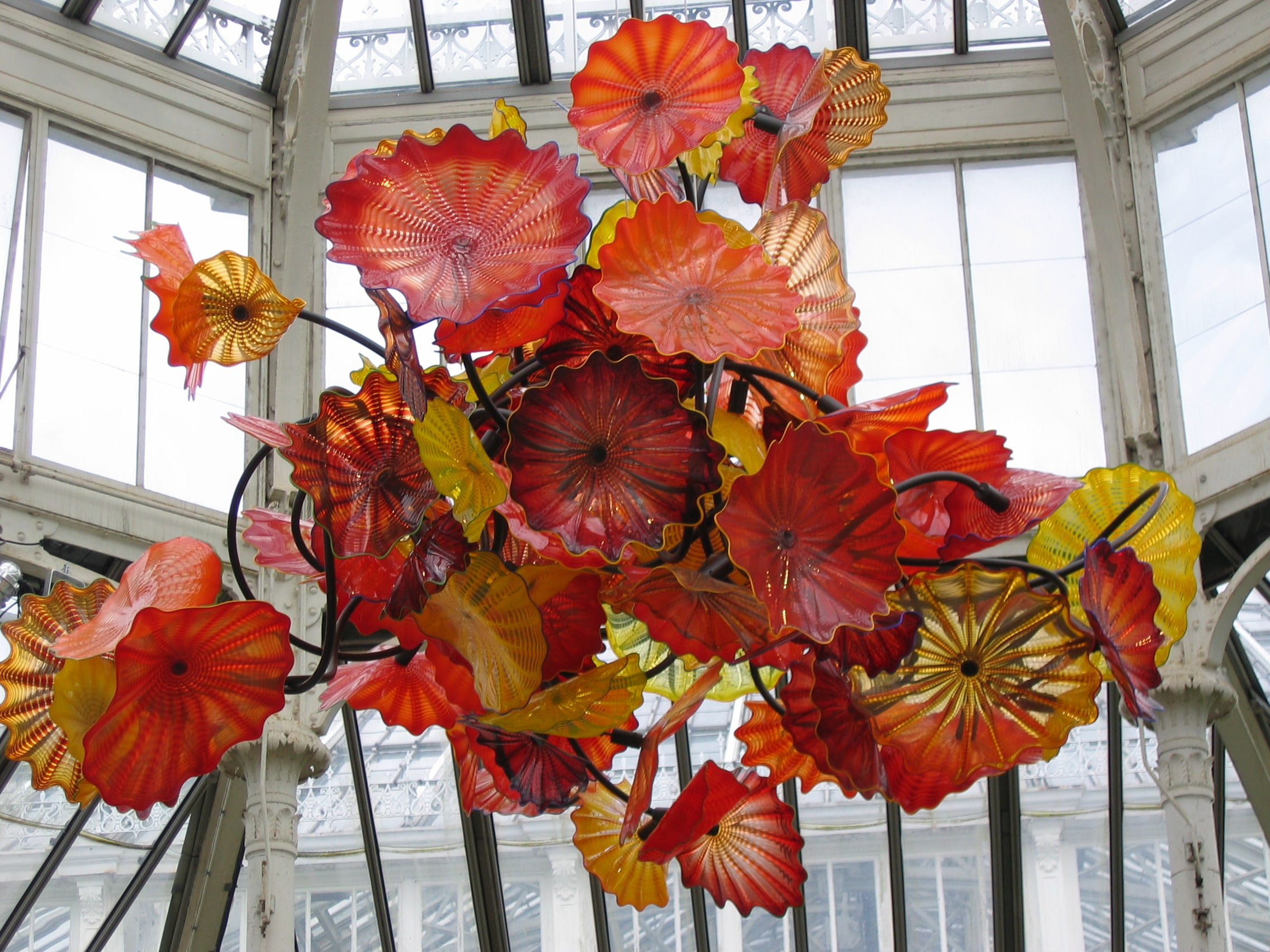
From Seattle to Singapore, Dale Chihuly’s magnificent art has graced public buildings, outdoor spaces and botanical gardens around the world.
Endlessly innovative, jaw-droppingly beautiful, weird, and often trippy, Chihuly’s work has redefined glass as an artist’s medium that expresses abstract forms and often looks almost alive. Even postcards of his work have a WOW factor. One in particular showcases loads of his Seaform pieces lining the bottom of a pool with a woman serenely floating above them.
Being one of the most honored, respected and well-known artists of our time, he’s fairly unreachable, so his website (www.chihuly.com) is the source of this tribute. Now 75, the Tacoma native has worked with glass since his undergraduate days at the University of Washington. When he blew his first glass bubble in 1965, he knew he had found his calling. Chihuly enrolled in the first academic glass program in the U.S. at the University of Wisconsin and went on to found the glass program at the famed Rhode Island School of Design.
On a Fulbright scholarship to Venice in 1968, he saw the team approach to glassblowing in action. That is still central to how he works. Always interested in collaboration, he had departed from the norm to work with another glass artist in college. A car accident in 1976 that permanently maimed one foot and cost him his left eye also shaped his team approach. Chihuly explains that he does not have the depth perception and balance needed to safely handle molten glass. Instead, he sketches his ideas and directs the team through the production process.
Chihuly co-founded Pilchuk Glass School on a tree farm in Stanwood, Washington in 1971. He has watched it grow from primitive working conditions to a world-class, international art glass center, mentoring many along the way. In 1994 he supported Hilltop Artists, a local glass art project for at-risk youth. Two years later, it was incorporated into the Tacoma Public School system.
He continues to innovate new forms, patterns and fusions. Rather than moving from one style to another, abandoning earlier ones, Chihuly continually builds a catalog of forms to reuse, extend and mix together. Some of his best-known styles include; Cylinders (a form he has revisited many times, some with textile-looking patterns and, more recently, a series inspired by James Joyce’s novel Ulysses), Seaforms (abstract, highly colorful, open bowl shapes like the prettiest clamshells ever imagined), Macchia (like Seaforms but with speckles of ground glass that utilize all 300 colors available in his shop, Persians (very large, fluted disks) and Venetians (squiggly tubes and flower-like forms in massed arrangements).
Some installations mix a variety of forms into veritable ecosystems of shapes and colors. Others are massive chandeliers or towers of blown forms carefully tied onto an armature (a sort of skeleton used to hold a sculpture together). Though known for his extravagant use of color, at times he immerses himself in clear or milky white or black or silver glass for a while.
He sums up his artistic vision this way, “I want people to be overwhelmed with light and color in a way they have never experienced.” When asked what his favorite color is, Chihuly replied, “I like to say I’ve never met a color I didn’t like.”
To other aspiring artists, Chihuly advises, “surround yourself with artists and see as much art as possible. Go with your gut and create something that nobody has ever seen.”
In 1986 he was honored with a solo show at the Louvre in Paris. Several cities have hosted installations involving multiple locations for his works. Most famous are the multi-installation exhibits; “Chihuly Over Venice,” with its colorful floats bobbing in canals and chandeliers hanging from its famous bridges, and “Chihuly in the Light of Jerusalem,” which broke attendance records in the year 2000 with over one million visitors.
“Chihuly in Tacoma” was a weeklong residency program back home, documented in a film called Chihuly in the Hotshop (available through the Humboldt County Library or Netflix DVD). Among hundreds of locations, his works have graced an Academy Awards banquet, appeared in Rockefeller Center in New York City, at the 2002 Salt Lake City Winter Olympics, the Clinton Presidential Library, Bellagio in Las Vegas, the Victoria and Albert Museum in London, the Smithsonian Institution in Washington, DC and in Monte Carlo.
In 1992 he designed sets for a Debussy opera in Seattle and in 2007 created sets for Bartok’s opera Bluebeard’s Castle, which has been staged in Seattle, other U.S. cities and Tel Aviv, Israel. This same year also marked the opening of the Chihuly-inspired Tacoma Museum of Glass. Though instrumental in the museum’s founding, he is careful not to dominate, wanting to showcase other glass artists. Twenty years after, the Chihuly Bridge of Glass was dedicated in his honor as the grand entryway to the Glass Museum.
Chihuly’s work appears in more than 200 museums worldwide; the list fills five pages online. Among his many awards are twelve honorary doctorates and two fellowships from the National Endowment for the Arts.
Dale Chihuly has elevated glass to fine art many times over. Through his years of experience and mastery, Chihuly is able to break from thousands of years of tradition to create glass art that not only inspires, it pushes boundaries.
Written by Molly Cate



Leave a Reply